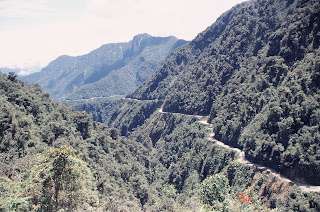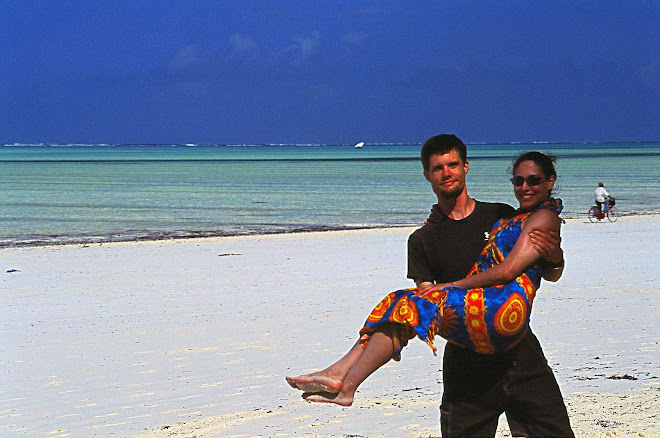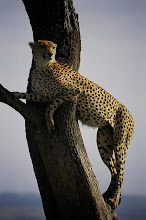
Between the barren altiplano capital of La Paz and the verdant Yungas coca capital of Coroico lies one of the most dramatic and deadly roads in the world. Built by the blood and sweat of prisoners during the war with Paraguay in 1932, the “Death Road” is still the only route that connects Northern Bolivia with the capital. This absurdly narrow road is heavily traversed by buses, minivans, trucks, tankers, taxis, private vehicles, and mountain bikes. Mountain bikes! That’s right; the world’s deadliest road is open for tourism, only in Bolivia. Despite the fact that (or because of it) there is an average of one accident every two weeks and 200 fatalities annually, tourists are just bursting go down this road and then proudly wear their “I Survived” t-shirts. Tourist companies are only too ready to oblige. There are no less than 25 companies in La Paz to provide for your adrenaline fix hundreds of mountains bikes (just think how many dodgy brake pads are out there?). Ironically enough, my father emailed us just after we booked our trip informing us that there is a deadly road near La Paz and we should “avoid it like the plague” (how does he learn about these places before we get there?).
 So when the next day arrived, Cara and I met our small group of six (including guide and driver), suited up in garishly ugly orange pants and jackets, grabbed our gloves and helmets, and piled into a mini-van whose paint job proudly advertised what it was that the crazy gringos inside were about to do. We climbed up out of La Paz (already at 3800m) to a ridiculous 4700m. Below the outstretched arms of a large Jesus statue we chased down bread and jam with coffee. We adjusted our seats, tested the breaks, kicked the tires, and prepared ourselves psychologically for the ride of our lives. After a very brief instruction from Wince, our guide, the time came. With Jesus at our backs at three miles high we slowly rolled down the paved road that fell into the valley below. It didn’t take long. After seconds we were rocketing down the mountain at horrifying speeds. One tiny rock in the road would have been disastrous leading to “hair, teeth, and eyes” on the road (to once again quote my father). With our knuckles completely white, our noses numbed, and ears deafened, we passed trucks going down.
So when the next day arrived, Cara and I met our small group of six (including guide and driver), suited up in garishly ugly orange pants and jackets, grabbed our gloves and helmets, and piled into a mini-van whose paint job proudly advertised what it was that the crazy gringos inside were about to do. We climbed up out of La Paz (already at 3800m) to a ridiculous 4700m. Below the outstretched arms of a large Jesus statue we chased down bread and jam with coffee. We adjusted our seats, tested the breaks, kicked the tires, and prepared ourselves psychologically for the ride of our lives. After a very brief instruction from Wince, our guide, the time came. With Jesus at our backs at three miles high we slowly rolled down the paved road that fell into the valley below. It didn’t take long. After seconds we were rocketing down the mountain at horrifying speeds. One tiny rock in the road would have been disastrous leading to “hair, teeth, and eyes” on the road (to once again quote my father). With our knuckles completely white, our noses numbed, and ears deafened, we passed trucks going down. We had two brief respites in the first two hours when we had to walk our bikes through two DEA check points (can our government keep its stinking nose out of anything?) There was an 8km section of uphill cycling, which ended up being a show of machismo by the guys more than anything. At 3600m (12000ft) this was a killer and it took me nearly 10 minutes of hyperventilating before I could control my breathing. Shortly after, the two lanes of pavement ended. The new road, that was supposed to be finished two years ago (I figure local officials must put on the finishing touches to their new houses with the international aid to build the road before focusing their attention on the road itself) goes up and the narrow rock and earth road (that kills people) continues down into the lush cloud forest. Welcome to the “Death Road” said Wince. He instructed us to go slowly and stay on the outside of the road as traffic coming up gets the right of way along the inside passage of the mountain. After a few minutes of cycling the view down into the valley opened up and the tiny brown ribbon of road could be seen meandering through the deep green mountains to the horizon. This first section of the Death Road is truly frightening.
We had two brief respites in the first two hours when we had to walk our bikes through two DEA check points (can our government keep its stinking nose out of anything?) There was an 8km section of uphill cycling, which ended up being a show of machismo by the guys more than anything. At 3600m (12000ft) this was a killer and it took me nearly 10 minutes of hyperventilating before I could control my breathing. Shortly after, the two lanes of pavement ended. The new road, that was supposed to be finished two years ago (I figure local officials must put on the finishing touches to their new houses with the international aid to build the road before focusing their attention on the road itself) goes up and the narrow rock and earth road (that kills people) continues down into the lush cloud forest. Welcome to the “Death Road” said Wince. He instructed us to go slowly and stay on the outside of the road as traffic coming up gets the right of way along the inside passage of the mountain. After a few minutes of cycling the view down into the valley opened up and the tiny brown ribbon of road could be seen meandering through the deep green mountains to the horizon. This first section of the Death Road is truly frightening.
We biked only two feet away from the precipitous edge that fell vertically nearly a mile into the river below. The only thing that remotely resembled guard rails was the steady line of black crosses on the most precarious sections. Above our heads hung a thick canopy of trees that clung to the vertical rock wall on our right. Several times small water falls would come down on our heads making the road muddy and slippery adding yet another challenge. One blind curve follows another. There are traffic controllers with red and green flags that perch themselves on the most dangerous sections of the road. For a fare of one Boliviano, 12 cents, they help the large buses and trucks manoeuvre around each other using the rare passing sections. Stand offs between large vehicles are frequent causing huge traffic jams and take up to 20 minutes to sort out.

Despite the gorgeous views you just couldn’t lose focus for one second. We learned that a French mountain biker lost her concentration and then her life when backing up from a truck during one of these jams. She went right over the edge backwards. Along the way Wince pointed places where all the mountain bikers had gone over during his 4 years of service. All the bus accidents were way too numerous to point out but the recent ones were still easily seen from the road. Some had crews of men trying to pull the wreckage back up onto the road as if we all needed yet another reminder of the dangers. I stayed right behind Cara in case she slipped or fell off her bike. Father Garuccio (Cara’s Dad) would kill me if anything happened to her (come to think of it, my own father probably would too). Cara hit some rocks and lost her footing while avoiding a large Volvo truck which nearly gave me a heart attack. As we neared the end of our journey at an elevation of 1200m (a huge differential from 4700m) the temperature and humidity made the going very uncomfortable in our orange suits. The dust from the never ending buses and trucks was not only choking, but completely obscured the road for several seconds. When we finally made it to the bottom we were glad to be finished. Our guide handed out our “I Survived” shirts after we pealed off our soaked clothing. We rewarded ourselves with some Pacena beer and enjoyed a huge feast for lunch. But it was still not over. In order to get back to La Paz we had to take the “Death Road” once again. Our driver knew all the curves and intricacies of the road. This unfortunately gave him a little too much confidence, in my opinion, as he sped around the corners at a very uncomfortable speed. As the shadows lengthened obscuring the valley bellow the other riders slept in the back of the van as I hung my head out the window on the cliff side with the wind blowing in my hair and eyes bulging down the abyss below absolutely terrified and completely delighted.





No comments:
Post a Comment